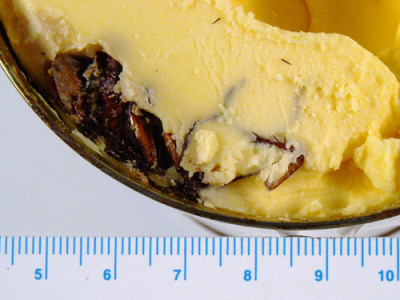Insects and Animals
Animals and insects are common but unwanted product contaminates. Animals and their parts may be discovered (or allegedly discovered) in food products, filth derived from raw ingredients, or even found embedded in pharmaceuticals. Wherever they are discovered, our task is to provide confirmation that the material is of animal origin, to identify the animal, and often to provide whatever constraints are possible on its point or time of introduction. Click here to read an excerpt of an article authored by a Microtrace scientist in a consumer affairs magazine that discusses some of the benefits of having a third party scientific analysis.
Identification
The examination is based upon our general approach for identifying food contaminants. The initial step is to determine if the material is, indeed, an animal-derived substance. Over the years we have encountered virtually every animal part imaginable, ranging from slices of snakes in frozen vegetables, to a battered and deep fried mouse, to teeth from consumers, and insects from all over the world. In many instances, the analysis focuses on identifying or looking for traces of insect or animal activity such as hairs, droppings, or bite marks. In some cases, the observed material turns out to be parts of an animal not intended to be used in a particular product.
With regards to identifying potential foreign material, the lay judgement of consumers, retailers, or manufacturers often turns out to be incorrect. For instance, animal tissue is often confused with clumps of product, cartilige with tooth, and char with droppings. All of these claims can be resolved through an objective analysis supported with scientific data. Analyses at Microtrace are based upon physical characteristics, microscopic anatomical features, hair identification, animal necropsies, and examinations of stomach and lung contents (along with any other information that we are able to extract from a sample). While the great majority of this work is done at Microtrace, there are instances, particularly when dealing with products that may have originated or been transported through another part of the world, where we enlist the help of a specialist with knowledge of a particular geographic region.
Point of Introduction
Following identification, determining when the foreign material was introduced to the product is often important. In some cases, this involves elucidating whether the animal was introduced before or after a package was opened, and in other instances, a manufacturing plant is attempting to learn where in its supply chain or manufacturing process a foreign substance was introduced. Although every examination is different, our sample-driven analytical approach has been very successful identifying or placing constraints on the point of introduction. This information has also withstood legal scrutiny when required.
How May We Help You?
Contact usto discuss your project in more detail.








